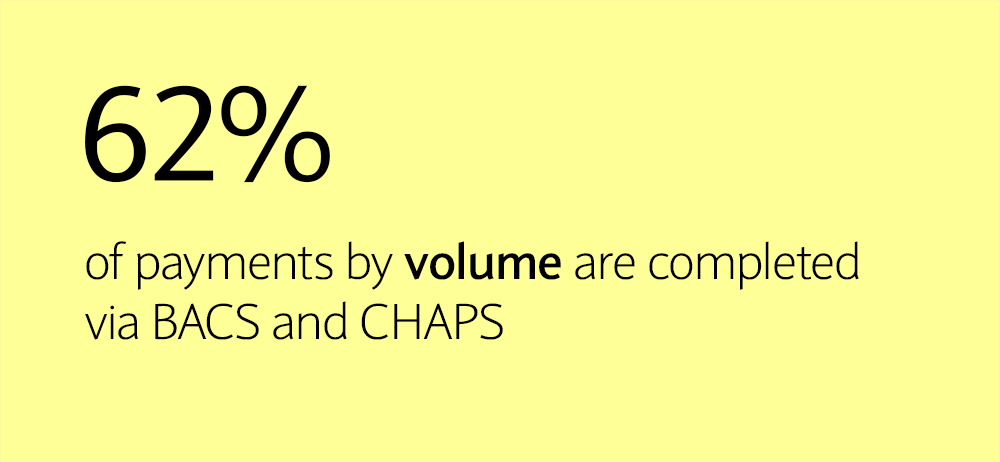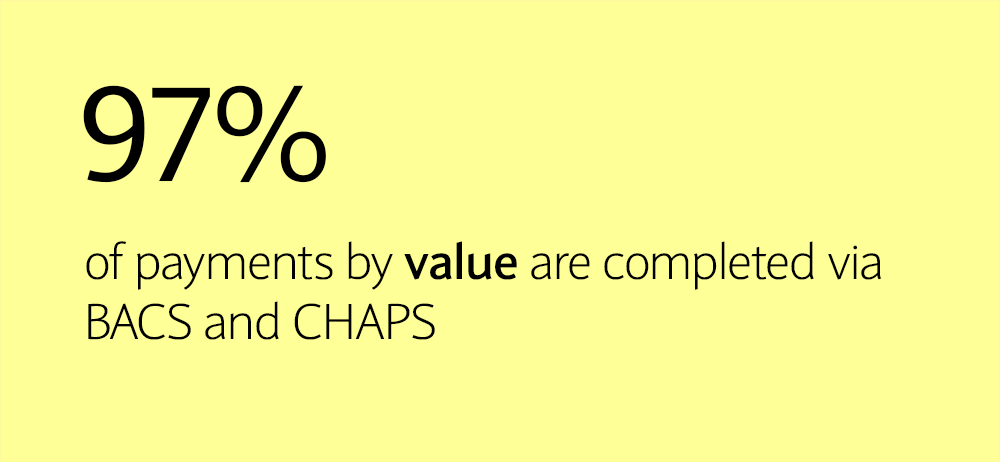
Optimise your business
Read the latest research, expert analysis and reports from Barclays Corporate Banking.

Like many countries, the UK has traditionally operated two different payment systems. BACS and CHAPS are the traditional workhorses for payments and in 2022 represented 62% of payments by volume and 97% by value.1
For many businesses, the selection of a particular payment scheme/ rail is based on legacy reasons. Systems have been designed to enable BACS files for low value batch payment processing and even now there are mainframes generating BACS payment instructions. As technology has moved on, many businesses have left the core customer systems in place and layered technology workarounds on top. CHAPS has been used for high value or urgent payments. The introduction of Faster Payments has consequently had only a small impact on payment activity (partially a result of the initial low ceiling of £100,000 per payment - increased to £1m in 2022).
In addition to system limitations, the adoption of Faster Payments has also been impacted by where payments are made. Supplier and payroll related payments are typically processed by payment factories, where a key priority is making sure the payment processes are resilient and robust rather than selecting the most appropriate payment scheme. Culturally, delivering a payment experience that benefits the supplier remains less important to a payments team than processing a payment correctly first time and on time.
For individuals and small and micro-businesses, the approach to payments is very different. Individuals have seen the benefits of seeing payments move within a few minutes and the idea of an expensive payment or a payment that takes three working days can be unacceptable. Small and micro enterprises recognise the importance of active working capital management and see the flexibility and immediacy of Faster Payments as a key tool as well as being more supplier centric.
This differing view of the value of payments reinforces a growing divergence in the use of the various payment schemes/ rails by the different parts of the economy.
The current ecosystem includes payments that clear overnight, some that clear during a working day and others that clear on a “real-time” basis. Daily cash management can consequently be an imprecise, manual and time-consuming process – especially if there are different teams processing outbound payments as closing cash positions can be impossible to forecast accurately.
As individuals, we are now used to receiving notifications of payments made or received. However, this is not universal for corporates and can result in the all too familiar process of logging into a payment system or calling up a bank to track an important or high value inbound payment.
These can be less than transparent. Whilst treasury teams are often responsible for negotiating payment tariffs with their payment processors, not all can or do verify that the agreed tariffs have been correctly applied. To make matters more complicated, if payments involve indirect payment system participants or correspondent banks, charges may be levied much later than the underlying transaction.
The payments landscape, having been static for several decades, is now changing and this creates new opportunities but also risks for businesses and treasury teams.
For decades, organisations such as the World Bank and the G20 group of nations have identified the implications for growth and economic development of the existing payment processes. Initiatives such as the EU’s Payment Services Directive and Open Banking in the UK have encouraged new entrants, competition and innovation supported by significant levels of investment by venture capital firms.
Although the UK was amongst the first country to deploy a “real-time” payment service in 2008, this is now becoming a global standard rather than an exception
In addition to changes to the infrastructure, there has also been an exponential rise in the use of APIs – enabling greater connectivity between different payment providers and fuelling the growth in new payment services.
As payers, payees, banks, central banks and governments see the benefits of a more diverse payments ecosystem, payment infrastructure providers are reviewing the capabilities of the existing rails. In the UK, the Payments System Regulator has encouraged the bringing together of the different payment rails (except for CHAPs) and the new organisation – pay.uk has been tasked with designing and implementing the New Payments Architecture. At the same time new initiatives are emerging globally including:
In response to authorised push payment fraud, countries are introducing the ability to verify the beneficiary bank details (including matching the name on a bank account) before a payment is executed.
A new payment standard ISO 20022 is being rolled out and payment systems around the world are migrating across over the next few years. It will enable more functionality by defining standardised payment fields and supporting significantly more payment information. Businesses should benefit from greater automation, lower transaction costs, faster settlements, greater traceability of a payment and improved credit control.
For more information please visit ISO 20022 for Corporates.
More than five years old, this new tool from SWIFT provides full transparency over where a payment is at any given moment. According to SWIFT, nearly 50% of gpi payments are credited to end beneficiaries within 30 minutes and most are credited within 24 hours.
Similar to a direct debit, this will allow customers to permit suppliers to make a series of payments on a customer’s behalf within agreed parameters, offering more control and transparency than existing alternatives. Compared with direct debits and continuous payment authorities, VRPs provide a clear audit trail and visibility in a banking app.
To help consumers budget more effectively, it has been recognised that offering payment choices can have a significant beneficial impact – especially to those most vulnerable in our society.
Why does this matter? The way in which payments have been processed has not changed materially for several decades and businesses have either accepted the status quo or built workarounds. Whether paying or receiving, most businesses and treasurers accept a different payment experience at work compared with one in their personal lives.
But now there is a real opportunity to reimagine payments – if you could re-engineer your accounts payable and receivables systems, what would optimise the processes for your business, customers and suppliers? How much do the newly emerging payment solutions support this greater flexibility and degree of customisation? And how can real-time payments align with a move to real-time treasury?
Most payment teams are presently focused on processing a payment over garnering insights, but increased data may allow you to make informed strategic and operational decisions. This includes:
What would happen if you embedded payments into the transaction process itself to create a frictionless activity (similar to paying for an Uber journey at the moment)? What impact could this have on the customer experience and on credit control activities?
Updating payable and receivable systems is neither cheap nor quick. However, it would be disappointing if these system upgrades were not seen as an opportunity to redefine the payment experience.
Treasurers need organisations they can trust to identify what is best for their businesses. At the same time, banks and FinTechs are keen to develop solutions for their customers and want to work with forward-thinking teams. As such, this is a once-in-a-generation opportunity for treasurers to get involved in the reimagining of the payment process. Leveraging their relationships with payment providers and identifying the needs of customers, suppliers and the payable and receivables teams, treasurers are ideally placed to identify potential use cases that go far beyond the settlement itself.

Read the latest research, expert analysis and reports from Barclays Corporate Banking.

We provide a complete spectrum of solutions to enable your business to transact and trade easily, manage risks efficiently and finance its plans for growth.

To discuss your business requirements and how Barclays can support you, contact us today.
1UKF Payment Markets Summary 2022.pdf (ukfinance.org.uk^)

